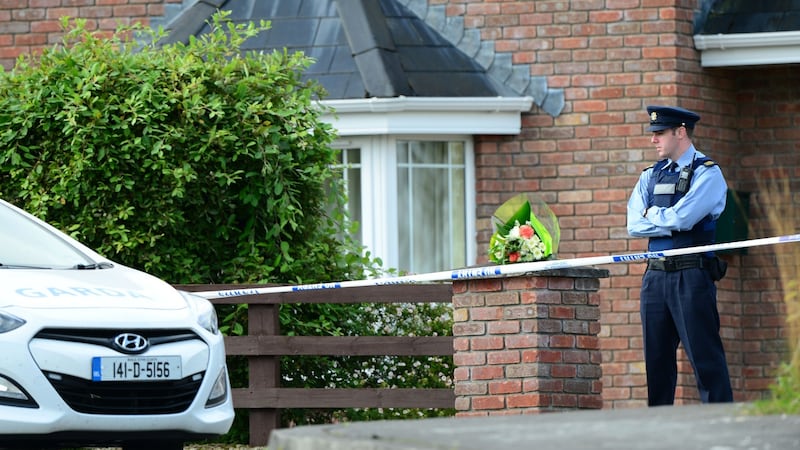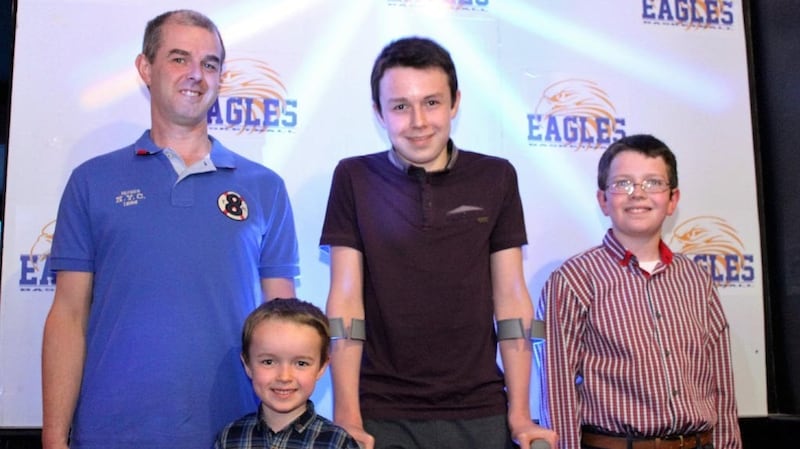The sole Sunday Mass at St Mary's Church in Castlerahan, near Ballyjamesduff in Co Cavan is at 9am, and this Sunday, Clodagh Hawe and her 13-year-old son Liam were due to give the two readings. Their names are listed in this week's single-sheet parish newsletter, copies of which were still lying in the vestibule of the church yesterday. Among the listings is a notice of a meeting in the local community centre about organising a tea-party for a forthcoming festival.
Above the table where the newsletters lay were two faded posters on the wall advertising support for anyone who may be at risk of suicide, or coping with its aftermath. The church was empty, but there was evidence that people had come there earlier in the day for solace, or to pray. Almost every spike on the brass plate designed to hold tealights contained a lit flickering candle.
You can see the playground of Castlerahan National School from the door of the church grounds opposite it.


This is where Liam Hawe went to school, and where his little brothers, Niall (11) and Ryan (6) were due to return to their classrooms this week. It is also where their father, Alan, worked as the school's deputy principal. You only have to look at the size of this small primary school to understand something of the devastating impact of losing two of its pupils and one of its staff members must be having on the rural community it serves.
Three members of one family who walked through its door every day of the school year, will now never be coming back.
School playground
Yesterday afternoon, the school playground was empty, and the yellow venetian blinds were down on all the front windows, but the car park was full. Inside, staff members were meeting to discuss the tragedy of the Hawe family’s deaths, supported by visiting psychologists from the National Educational Psychological Service.
There was the sound of grass being methodically mowed on a neighbouring lawn. On the noticeboard outside the school, held neatly in place by magnets, was a single piece of paper; a short statement from the principal, Anne Foley.
“This is a terrible tragedy for the family, our school and our community,” one of the sentences stated with bleak simplicity. “Niall and Ryan were pupils in our school and Liam was a past pupil. They were wonderful children who will be greatly missed by all who knew them.”
It is less than a five-minute drive from Castlerahan National School, through bucolic green fields with grazing cattle, to the entrance of the estate where the Hawe family lived. The Barconey Heights estate, on the left-hand side of the road towards Ballyjamesduff, has just four houses in it, arranged in a type of semi-circle.
They are all two-storey, with upstairs dormers, and are close enough to be in earshot of each other. The Hawes’ house is the third one, slightly uphill and partially hidden from the road, but unmistakable due to the crime-scene tape at its entrance.
Passing cars slowed down as they approached the estate, with many passengers blessing themselves as they were driven past. The entire estate was closed off to the public, with tape running between the red-brick entrance pillars and two gardaí on duty to ensure nobody walked in.
The complete absence of flowers and cards, or tributes of any kind from the public that have become a sadly predictable accompanying motif in marking tragic deaths, was striking. More than a day had elapsed since the dreadful news broke, but there were no flowers, cards, or messages at the entrance to the Hawe family home, nor any at Castlerahan National School, or at the church.
Flowers
If flowers are ultimately futile at such a time of horrific tragedy, so too are words.
On the streets of Virginia and Ballyjamesduff, members of the public did not want to comment on the deaths of five of their own fellow Cavan neighbours. When approached, people grimly shook their heads and turned away in silence.
Nobody had any words for what happened in the Barconey Heights house sometime on Sunday night or Monday morning, and they made it clear they did not want to try.
Clodagh Hawe was due back at work this week in her job as a teacher at Oristown National School. The school is a few miles outside Kells, past the golf club, and the extensive stone walls of Headfort School and its vast green demense.
The Oristown principal, Ann O’Kelly Lynch, said in a statement that “Clodagh was a much loved and valued teacher in our school”. Yesterday, children were back in their classrooms, in this small school in rural Meath, where one class was missing its teacher.
The first thing you see when you go in the school door is a laminated notice, affixed to the wall beside a copy of the 1916 Proclamation. It is headed “Child Protection” and carries the name of the school’s two designated child protection liaison officers.
Clodagh Hawe would have passed this sign every time she came to work. She could never have imagined that one unimaginable day her own three children would be in need of protection in their own home.

















